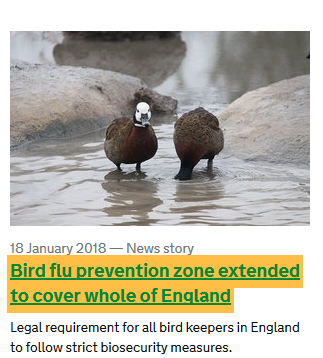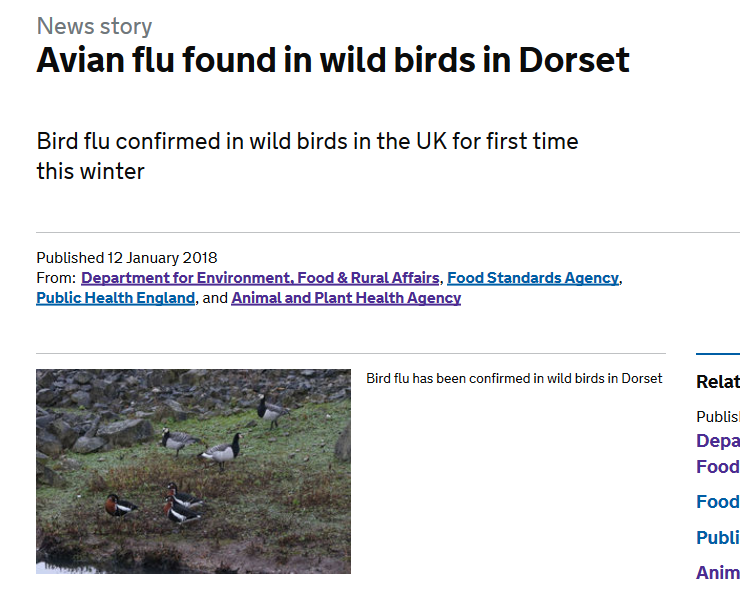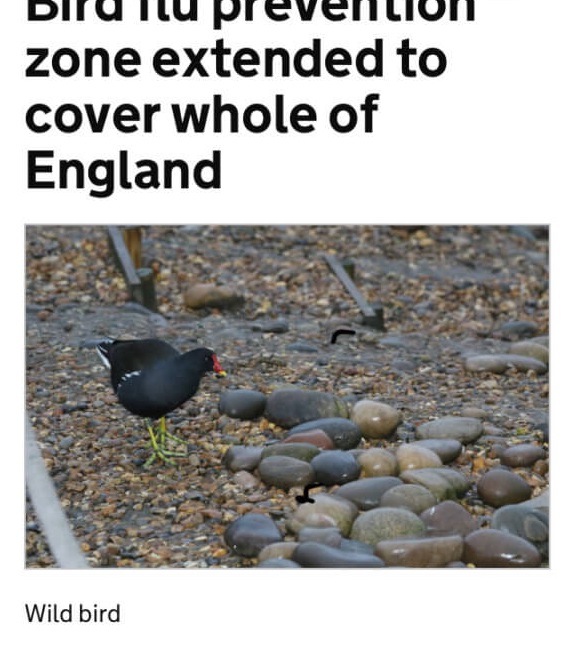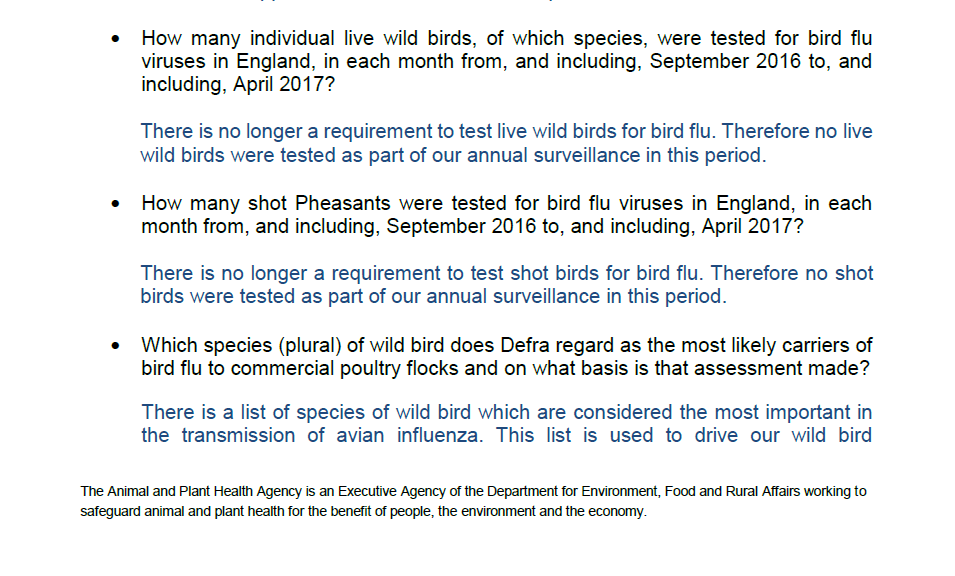It looked as though we might get through this winter without avian flu arriving on our shores but no such luck. After the first case was detected at the swannery at Abbotsbury there is now another case involving 13 wild birds in Warwickshire.
Let’s hope that there are no more cases affecting poultry and poultry keepers.
The thrust of this blog is my ongoing lack of confidence in Defra’s ability to understand much about wild birds. Don’t get me wrong, I am perfectly sure that wild birds play a part, probably a very large part, in spreading avian flu but it is actually because of that belief that I am very interested in what the mechanisms might be, which species are most involved and matters like that. In that respect Defra does not inspire much confidence.

The species chosen by Defra to illustrate their instructions to poultry keepers about registering flocks (above) is not a hen or a turkey, nor is it any wild bird, it is, I believe, a White-faced Whistling Duck – a species of southern Africa and South America which is not a commercially important species in the UK, not a wild bird in the UK, not a naturalised species in the UK and not a species particularly commonly kept in wildfowl collections. It is, quite simply, a very odd choice, but I doubt that Defra vets will have bothered about that because it seems that all ‘wild birds’ are the same to them.
The images chosen by Defra to illustrate the arrival of avian flu in ‘wild birds’ in Dorset was this one:

If there are three wild Red-breasted Geese with three wild Barnacle Geese in Dorset then I’d be very surprised. But that doesn’t seem to matter to Defra because ‘wild birds’ are the problem here and it seems like the Defra definition of a wild bird is anything that isn’t incarcerated on a poultry farm.
Defra used a different image to illustrate the story in their media blog:

… and helpfully labels the image as a ‘wild bird’. It is a Moorhen – and this one may well be a wild bird! Well done Defra.
Now, I am not the pickiest (nor the most knowledgable) of birders, and I’m not pointing out this approach by Defra just to show that sometimes I can identify a bird or two, it’s because whenever it comes to knowledge of birds in relation to avian flu, Defra always looks ignorant. And if you want to move towards the most effective forms of prevention of the spread of avian flu then the more you understand about the means of spread of the disease the better (surely?).
You may have noticed that all four of the species used here are waterfowl even though three of the four look as though they are probably captive waterfowl rather than wild birds. And you might think that is fair since you might have a vague recollection that most of the wild birds which have been found to have the avian flu virus (there are several viruses but there is usally a particular virus of relevance each year) were waterfowl. If you have that memory then you are right – here are the positive avian flu cases found in dead wild birds submitted to Defra last winter.
But you’ll notice that these are just the positive cases. How many negative cases were there? How many species were tested? How about live birds? Well, I asked Defra that a while ago and I’ll tell you the answers in a minute.
But let’s just imagine that the police had a very high propensity to stop and search young black men in poor parts of town – couldn’t possibly happen could it (?), but let’s just imagine. A table of people found carrying drugs or knives or anything else (like iPads) would have a lot of young black men from poor parts of town in the list. Only if we know how many old men, white men, women of all ages, and from affluent parts of town, can we make much of the list. So it is with birds testing positive for avian flu.
It could be that every individual wild bird in the UK was carrying the avian flu virus last winter (no, I’m not suggesting they were, but just imagine) but that waterfowl were more susceptible to the virus and therefore more of them died and so more of them were lying around to be sent in to Defra. And even for non-birders, it’s a lot easier to notice a dead Mute Swan (large bright white bird) than a dead Wren (small brown bird). And then, given that many nature reserves are wetlands and have staff looking at birds, one could imagine that waterfowl might be quite likely to be sent in to Defra. There are all sorts of things we might want to know to be able to interpret the list of wild (dead) birds which tested positive.
If we really wanted to learn about the prevalence of the virus then we would test lots of species, including live birds. So this is what I asked Defra and how they replied.



I am interested in the fact that no live wild birds are tested and no shot gamebirds are tested. It’s not that easy to sample live birds because you have to catch them first, but it is certainly not very easy to say anything interesting about the prevalence of avian flu virus in wild birds by testing for it in a sample of dead birds.
And despite Pheasant farms being hit by avian flu last winter, not one of the 40+ million Pheasants (the most numerous single bird in the UK remember!) was tested – and that’s despite the fact that about 25+ million of them are shot each year and they are so numerous that they are dumped in bag loads in the countryside!
My interest in this subject is not at all primarily because of Pheasants, but it does strike me as weird that Defra does not sample the commonest ‘British’ ‘wild’ bird despite it being so numerous, so widespreadso easy to come across as a dead bird and being the type of species that might well get close to chicken sheds in the normal course of events – more likely than, for example, a Pochard.
But let’s look at the species (all dead birds) that were tested by Defra.
Over last winter (September 2016 – April 2017) there were 588 dead birds tested for avian flu in England. If I ignore the 57 birds tested before the beginning of December (as bird flu arrived in UK in early December 2016) then the species tested and the positive cases are as follows:
| Species | # dead birds tested | # birds +ve for avian flu | %birds tested +ve |
|---|---|---|---|
| Mute Swan | 200 | 11 | 6 |
| Black-headed Gull | 55 | 2 | 4 |
| Various not identified to species and/or Aylesbury Duck | 41 | 0 | 0 |
| Mallard | 39 | 1 | 3 |
| Whooper Swan | 35 | 2 | 6 |
| Canada Goose | 19 | 2 | 11 |
| Buzzard | 17? | 3 | 18 |
| Wigeon | 13 | 9 | 70 |
| Moorhen | 13 | 0 | 0 |
| Starling | 13 | 0 | 0 |
| Greylag Goose | 11 | 3 | 27 |
| Coot | 11 | 0 | 0 |
| 'Partridge' | 8 | 0 | 0 |
| Herring Gull | 7 | 0 | 0 |
| Common Gull | 5 | 0 | 0 |
| Bullfinch | 4 | 0 | 0 |
| Tawny Owl | 4 | 0 | 0 |
| Tufted Duck | 3 | 1 | 33 |
| Teal | 3 | 0 | 0 |
| Barn Owl | 3 | 0 | 0 |
| Greenfich | 3 | 0 | 0 |
| Pochard | 2 | 2 | 100 |
| Cormorant | 2 | 1 | 50 |
| Bewick's Swan | 2 | 0 | 0 |
| Goshawk | 2 | 0 | 0 |
| Red Kite | 2 | 0 | 0 |
| Sparrowhawk | 2 | 0 | 0 |
| Shelduck | 2 | 0 | 0 |
| Peregrine | 2 | 0 | 0 |
| Kestrel | 1? | 1 | 100? |
| White-fronted Goose | 1 | 1 | 100? |
| Grey Heron | 1 | 0 | 0 |
| Water Rail | 1 | 0 | 0 |
| Great Black-backed Gull | 1 | 0 | 0 |
| Snipe | 1 | 0 | 0 |
| Rook | 1 | 0 | 0 |
Most of the birds tested were waterfowl, so it is no surprise that most of the birds testing positive were waterfowl.
I do just wonder how bird flu gets from a Whooper Swan to a flock of captive chickens or turkeys. Of course, waterfowl will be defecating as they fly around the country so that could be a source of infection. But it’s a shame we don’t have more information – well, I think so anyway.
What about Pheasants – the commonest bird in the UK? What about House Sparrows – completely absent from the list of tested species but ones which are very likely to infiltrate hen houses, or share their food, or crap on the sacks of poultry food? How about Starlings – not many of them tested? Gulls – especially perhaps Black-headed and Common Gulls?
This doesn’t seem to me to be a very good surveillance strategy and it doesn’t seem to me to lead to better knowledge which might help poultry keepers and the public.
[registration_form]
Given the apparently unfocused nature of the data collection, one wonders whether its purpose has ever been carefully thought through.
To be even pickier than you Mark, as our friend Derek Yalden used to remind me, the commonest bird in the UK is not the pheasant but the chicken -150-160 million.
Pheasants are reared in vast numbers and released in artificially high densities. They are then actively dispersed around the countryside by lines of beaters driving them towards guns. They are habituated to food provided by humans at feeding stations and so they readily adapt to visit poultry farms and rural gardens where poultry are often kept (up to 10 at a time raid the food we put out in our garden for chickens and wild birds). They are readily available as dead birds through shooting at next to no expense. If there was one single species you would expect to be tested for avian flu then it is this one.
Also Rock Doves and Wood Pigeons.
Oh well, I await the Countryside Alliance, promulgating increasing wildfowl shoots or even mass culls of wildfowl (as with badgers). But fighting any interference with the pheasant and grouse farms.
Bird flu to an extent must be endemic in some bird populations but the real problem and interest should be how does it get from there to domestic stock? The Defra (APHA) methodology explores that not at all and all we have is the testing of some wild birds in most of which the sample size is so small as to tell us very little. Surely we should be testing species commensal with man or at least his domestic chickens live and dead, pheasant is a prime example, starling, house sparrow others. It may well be the disease is brought each year with migratory birds that would not be a surprise nor is it necessarily relevant to the disease in domestic stock.
I for one have often thought that in many cases it is a disease of domestic stock moved about by man although that is obviously not the whole picture.
There are repeated references to Pheasants being the commonest bird in the UK in this blog. Out of curiosity where does that statistic come from? I wouldn’t be particularly surprised if it was true but I would be interested to see the data.
50 million captive bred pheasants released each year.
Ezra – try googling ‘number of pheasants released in uk each year’ and then google ‘population levels of UK birds’. The latter will probably take you to an excellent article in British Birds (where you’ll see that the Pheasant is listed as 2million pairs (only) because the authors don’t count the released individuals (partly because most of them are shot).
Thanks for the reply Mark, I’ve seen the British Birds article and the 2 million figure before. What can’t seem to find is any consistency in figures for the number of released birds. Everyone seems to agree that it’s in the tens of millions but then range from 35 million to 50 million which is quite a big difference!
Either way still obviously enough to dwarf the figures for pretty much everything except, as Jeremy said, chickens (cerca 20 million placed per month according to figures on go.uk).
Ezra – well spotted. I thought I had the figure of 40 million from the GWCT in the past but they now seem to be saying 35 million and evryone else seems to be creeping up in their estimates. fact is, probably no-one knows exactly. Maybe releases should be licensed – you can’t let millions of White-tailed Eagles lose and not account for each one!
There are autumn estimates for pheasants, red-legged partridges and wild native seed eating birds up to 2011 given in the book ‘Wildlife conservation on farmland. Volume 2: conflict in the countryside’ by Macdonald and Feber (2015) in sections 9.2 and 9.4. They show some striking graphs for biomass and food demand.
Their estimates line up with the numbers declared to the Great Britain Poultry Register, which was enforced quite rigorously in 2011 due to concerns over avian ‘flu.
I am not a scientist, but I fail to understand how relevant this information could ever be, given that they only test dead birds. It tells them precisely nothing about what’s happening in real time within the countries bird populations. The results are obviously going to be completely skewed by their own methods of sampling
I wonder if the RBG & barnacles are at the London wetland centre ? maybe even taken on Michael Gove’s I-phone during the 25 year plan launch ? Any speculation on the others ?
It does rather illustrate the problem of a pure generalist civil service – it really is quite hard doing the job when you know absolutely nothing about what you are doing.
Mark, It is interesting that Defra classify released game birds as wild birds yet in the Judicial review decision regarding Common Buzzards released game birds were continued to be described as stock under the care of man following their release. In the Defra context it is used to emphasise that gamekeepers are not responsible as are other bird keepers during these restrictions. Seems like having your cake and eating it too!
Alastair – indeed.